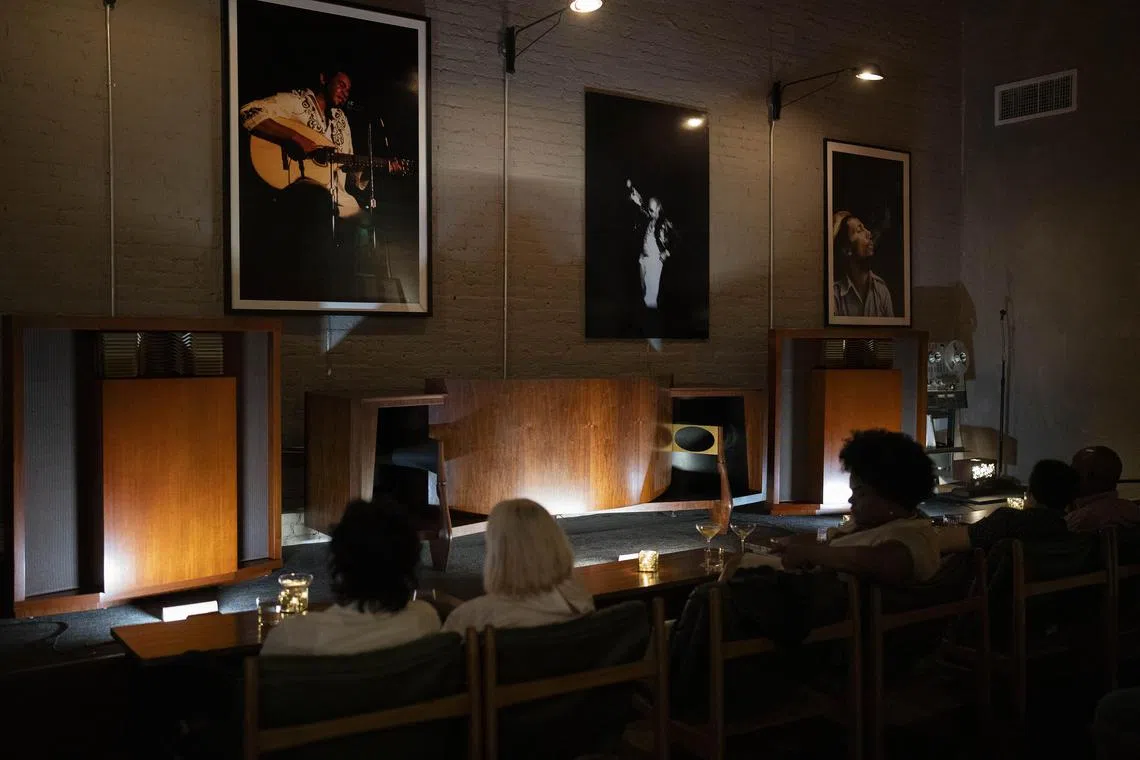The music is too loud. That’s the point
Sign up now: Get ST's newsletters delivered to your inbox

Patrons sitting in front of the speakers at All Blues, a listening bar in Tribeca in New York, where the crowd is asked to stay silent.
PHOTO: HIROKO MASUIKE/NYTIMES
Brian Josephs
Follow topic:
NEW YORK – One Friday evening, the conversation in the backroom of All Blues in Tribeca, where about two dozen people sat in leather chairs, was overtaken by the music streaming from three large, mid-20th century speakers.
Behind a DJ booth, Mr Yuji Fukushima, 62, owner of the bar, spun a set that included 1980s funk and late-career Dizzy Gillespie, which played from a pair of Germany-made turntables.
Around the room were rare McIntosh amplifiers, a tape recorder from a Swiss audio company and the three speakers – JBL products that altogether cost tens of thousands of dollars.
The bar’s patrons were enjoying what Mr Fukushima called a “music massage”, inspired by some of his favourite hangouts in Japan, where he grew up.
The lounges, better known as listening bars or listening rooms, are typically centred on a high-quality sound system that plays vinyl records. These bars stem from Japanese cafes, known as jazz kissas, which have a similar focus.
In the past year, listening rooms in New York, as well as in other cities, have opened with increasing frequency.
Nightlife proprietors point to the sustained popularity of vinyl and a lingering hesitance towards large gatherings after the pandemic. Tokyo Listening Room and Another Country are others that have opened in Manhattan.
All Blues, which opened in October 2023, sticks to the quieter, more contemplative atmosphere that characterises the traditional jazz kissa.
“I see the music bars open here and there, but those are different from what I know from Japan,” said Mr Fukushima, who also owns a boutique clothing store, Blue In Green, in Soho.
DJ Spinna, who has been playing a biweekly set since All Blues opened, likened stepping into Mr Fukushima’s bar to walking into another realm. “Everyone who walks in that place is just mesmerised. It’s like walking into another world,” he said.
In the Crown Heights neighbourhood of Brooklyn, a popular cocktail bar, St Ends, reopened in February 2024 as Kissa Kissa. It swopped a set-up that included iPad playlists on Sonos speakers for a roughly US$40,000 (S$54,500) sound system that spun jazz vinyl from the 1950s to mid-1970s – although it is less strict about chatter than All Blues.

Record Room, in the Long Island City neighbourhood of Queens, has the energy of a bustling speakeasy and the atmosphere of a dance party.
PHOTO: ALI CHERKIS/NYTIMES
Over in Queens, Record Room has the energy of a bustling speakeasy. After walking past the entrance’s cafe and shelves of vinyl records, the atmosphere is more like that of a dance party. The crowd joins together in full-volume sing-alongs and line dances to modern R&B hits.
To Ms Nia Bolling, a copywriter in Brooklyn who frequents Record Room and other listening bars, the vibe may be great, but the sound system is the main appeal.
“There are some places you go where you mostly care about dancing, or you mostly care about socialising,” said the 31-year-old. “But with listening rooms, you mostly care about the music and how it sounds. It’s stimulating, but it’s mostly stimulating from an audio perspective.”
Another bar drawing an audiophile crowd is Eavesdrop, in Greenpoint, Brooklyn, which strikes a balance between contemplative and festive. The songs playing through its bright yellow speakers are at their most crystalline when a visitor stands a few feet in front of them, in a space the size of a living room that is nestled between the confabs of its bar area and the backyard.

Listening bar Eavesdrop in Greenpoint, Brooklyn, strikes a balance between contemplative and festive.
PHOTO: HIROKO MASUIKE/NYTIMES
“There’re a lot of experiences out there,” said Mr Karl Brisseaux, a DJ based in New Jersey who regularly visits listening bars.
“You can have a vinyl bar or listening bar that’s more of a party atmosphere, or more of a laid-back atmosphere – one that’s more focused on just sitting and listening.”
The jazz kissas of Japan peaked in popularity in the 1950s and 1960s – when they gave young audiophiles a place to listen to prohibitively expensive jazz records – and declined as CDs became available and buying music grew cheaper.
Recently, though, jazz kissas are experiencing a revival in Japan, alongside a sustained rise in vinyl sales, according to adjunct professor Lasse Lehtonen from the Asian studies and musicology department at the University of Helsinki in Finland.
“There are not so many spaces in our contemporary world where you’re actually going to enter a very specific space where you kind of focus on doing something, such as listening to music and really appreciating that music,” he said.
Mr Danny Keith Taylor, an audio designer who has worked with hospitality spaces including Eavesdrop, said the trend reflected an expanding interest in sound design.
Before the pandemic, hospitality spaces tended to hide their audio equipment from the view of patrons, but owners are now more willing to display it as a focal point.
Mr Taylor, 41, said he saw listening bars as “the tip of the spear, of a broader movement of people paying more attention to audio”.
The intimate focus of these bars can be a contrast with the daily cacophony outside their doors.
Their popularity, Prof Lehtonen said, is “probably also symptomatic of our contemporary world that an interest in these kinds of spaces has risen and re-emerged”. NYTIMES

